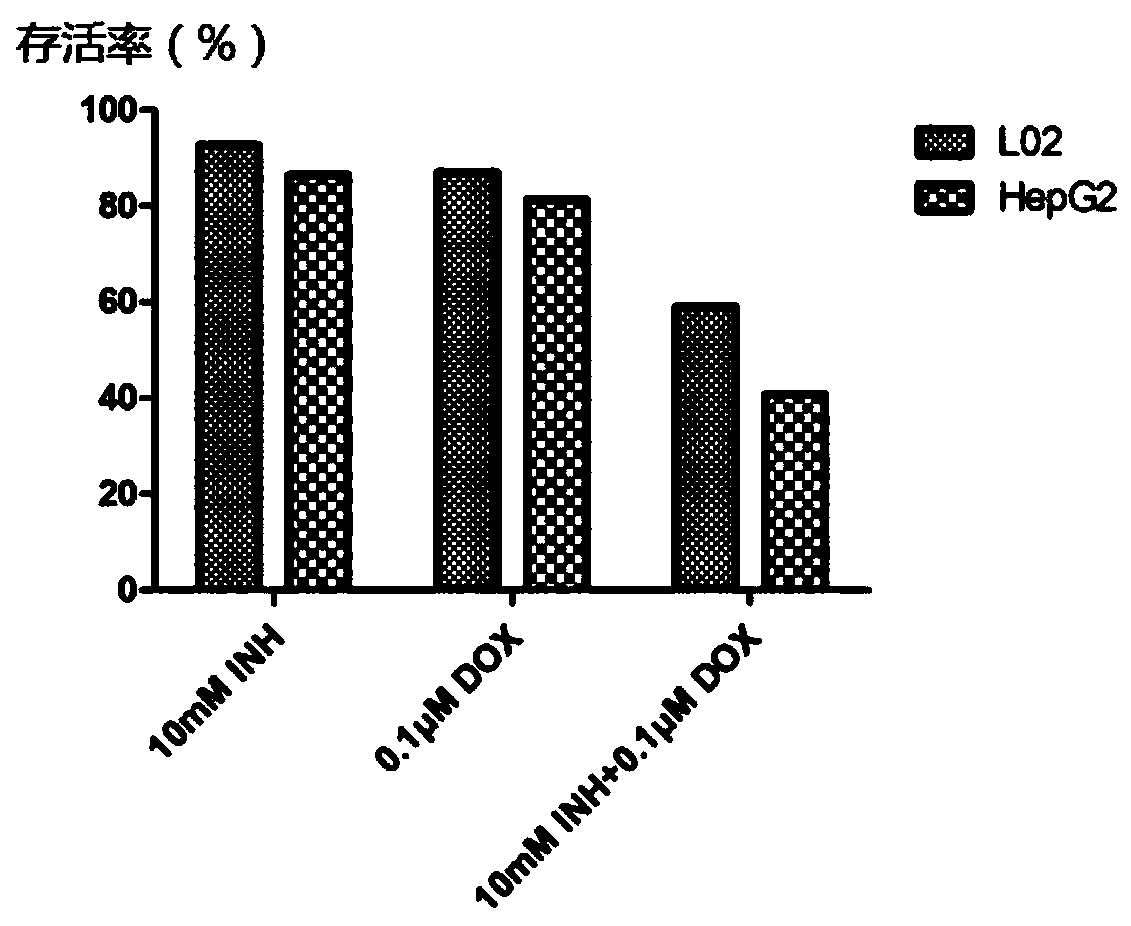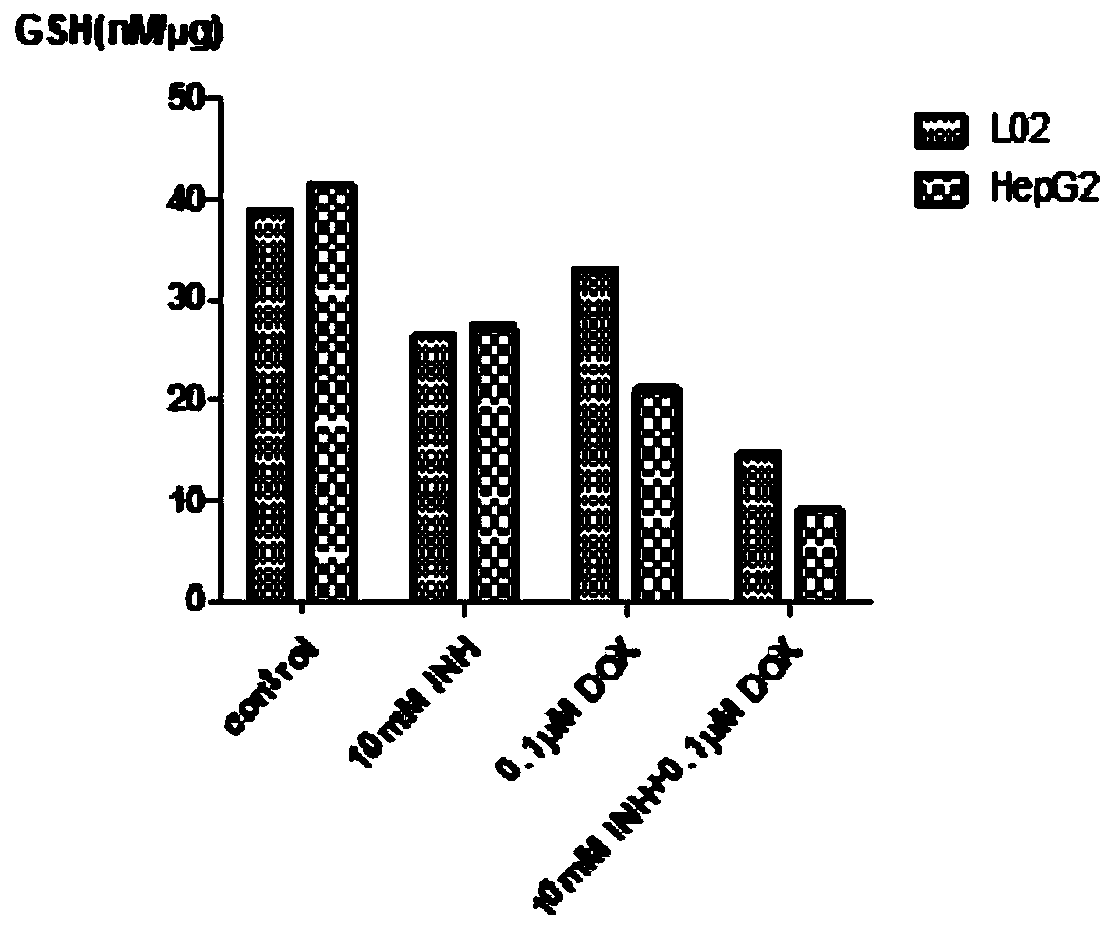Anti-tumor drug and application of isoniazid in preparation of anti-tumor drug
An anti-tumor drug, isoniazid technology, applied in the field of biomedicine, can solve the problems of weak inhibitory effect on tumor cells, poor effect of anti-tumor drugs, and damage to normal cells, so as to improve the effect of chemotherapy, ensure drug efficacy, and reduce The effect of lethality
- Summary
- Abstract
- Description
- Claims
- Application Information
AI Technical Summary
Problems solved by technology
Method used
Image
Examples
Embodiment 1
[0029] Firstly, isoniazid was prepared as a stock solution of 1 mol / L, and diluted to 10 mM with DMEM culture solution containing 5% fetal bovine serum before adding the drug, ensuring that the volume occupied by double distilled water did not exceed 0.5%. like figure 1 , is the group without any treatment as the control group, isoniazid 10mM and doxorubicin 0.1μM single action group, and isoniazid 10mM and doxorubicin 0.1μM combination group (isoniazid The mass ratio to doxorubicin is 25230:1) cell viability.
[0030] In terms of cell treatment, the cells in the logarithmic growth phase were taken, and 5×10 3 Cells / well were inoculated in a 96-well plate, and the total volume of culture medium in each well was 100 μl. After the cells grew for 24 hours, they were given different drug treatment schemes. The cells were cultured for 24 hours, and after 24 hours, the cell viability was detected by sulforhodamine B (SRB method). see results figure 1 . The horizontal axis repre...
Embodiment 2
[0032] The concentration of reactive oxygen species in cells is closely related to survival outcomes such as apoptosis. figure 2 Among them, DOX means doxorubicin, the dose concentration is 0.1 μM; INH means isoniazid, the concentration is 10 mM; DOX+INH means 0.1 μM doxorubicin combined with 10 mM isoniazid (isoniazid and doxorubicin The mass ratio of the star is 25230:1). After 2 hours of drug intervention, the fluorescent probe DCFH-DA was used to detect the changes in the concentration of intracellular reactive oxygen species ROS. figure 2Among them, in the doxorubicin alone group, the intracellular ROS of the two cells increased, and there was no statistically significant difference between the cell lines; in the isoniazid alone group, the intracellular ROS of the two cells increased, and The increase of intracellular ROS concentration in HepG2 was significantly higher than that in L02 cells; in the isoniazid and doxorubicin combined group, the increase in intracellula...
Embodiment 3
[0034] The ability of tumor cells to scavenge reactive oxygen species is weaker than that of normal cells. Utilizing this feature, the activity and content of antioxidants can be inhibited, so that cancer cells can further reach or approach the "death threshold" of oxidation levels, and enhance the effect of chemotherapy. Reduced glutathione is the main source of sulfhydryl groups in most living cells, plays an important role in maintaining the proper redox state of protein sulfhydryl groups, and is a key antioxidant in animal cells. In this example, GSH and GSSG detection kits are used to detect the contents of GSH (reduced glutathione) and GSSG (oxidized glutathione), and at the same time, the ratio of intracellular glutathione to oxidized glutathione to test. image 3 It is the reduced glutathione content in HepG2 and L-02 cells of each group in the experiment of 10mM isoniazid combined with 0.1μM doxorubicin (the mass ratio of isoniazid to doxorubicin is 25230:1). Figur...
PUM
 Login to View More
Login to View More Abstract
Description
Claims
Application Information
 Login to View More
Login to View More - R&D
- Intellectual Property
- Life Sciences
- Materials
- Tech Scout
- Unparalleled Data Quality
- Higher Quality Content
- 60% Fewer Hallucinations
Browse by: Latest US Patents, China's latest patents, Technical Efficacy Thesaurus, Application Domain, Technology Topic, Popular Technical Reports.
© 2025 PatSnap. All rights reserved.Legal|Privacy policy|Modern Slavery Act Transparency Statement|Sitemap|About US| Contact US: help@patsnap.com



